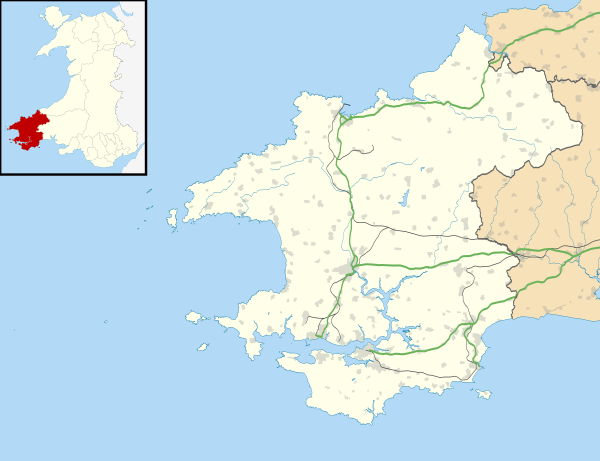Monington, Pembrokeshire
Monington (Welsh: Eglwys Wythwr) is a small settlement and parish in the community of Nevern, north Pembrokeshire, Wales. It is on the Nant Ceibwr (Ceibwr Stream) that flows through Moylegrove and into Ceibwr Bay. Part of the parish lies within the Pembrokeshire Coast National Park.
Monington
| |
|---|---|
 Parish church of St Nicholas | |
 Monington Location within Pembrokeshire | |
| OS grid reference | SN132440 |
| Community |
|
| Principal area | |
| Country | Wales |
| Sovereign state | United Kingdom |
| Police | Dyfed-Powys |
| Fire | Mid and West Wales |
| Ambulance | Welsh |
Name
Monington’s Welsh name translates into English as the "church of eight men", reflecting the fact that there were eight freeholders in the parish when it was founded.[1] The origin of the English name is obscure.
Description
Monington is a rural parish[2] in the community of Nevern, close to the source of Nant Ceibwr, the stream that flows through Moylegrove and into Ceibwr Bay. The parish is in the Diocese of St David's and the parish church is dedicated to St Nicholas.[1] The present church, built in 1860,[3] is a Grade II listed building, built in 1860 in high-Victorian Gothic style.[4][5]
There are 11 other listed buildings or structures in the parish, including several at Pantsaeson in the north of the parish.[6]
History

Dyfed Archaeological Trust records suggest that a battle took place at Pantsaeson in the early medieval period.[7]
The earliest-known written records of Monington are from the 13th century when knight's fees were contributing to the manor of Maenclochog.[8] Parishioners of Monington in the 16th century held ancient grazing rights in the Preseli Mountains resulting from an historic association with St Dogmael's Abbey.[9] From 1536 Monington was in the Hundred of Cemais,[1] and it is marked as Egloiswither on a 1578 parish map of Pembrokeshire.[10]
An 1838 tithe map of Monington shows named buildings, mills, mill leat, mill pond, gardens (with paths), farmyards, fences, orchard, parkland, woods, quarry (gravel), hill-drawing, footpath and/or bridleway, waterbodies, springs, well and a kiln.[11]
The quarry referred to in the tithe map, Cware Trefigin, was still in operation in 2019 and contains significant deposits of sand and gravel.[12]
References
- "GENUKI: Monington". Retrieved 1 May 2015.
- "GENUKI Parish map (5)". Retrieved 1 May 2015.
- "Royal Commission (Coflein): St Nicholas, Monington". Retrieved 2 May 2015.
- "British listed buildings: St Nicholas, Monington". Retrieved 1 May 2015.
- Cadw. "Church of St Nicholas (Grade II) (12781)". National Historic Assets of Wales. Retrieved 29 July 2019.
- "British listed buildings: Nevern". Retrieved 1 May 2015.
- "Royal Commission (Coflein): Pantsaeson". Retrieved 2 May 2015.
- "Dyfed Archaeological Trust: Maenclochog". Retrieved 2 May 2015.
- "Dyfed Archaeological Trust: Llethyr". Retrieved 2 May 2015.
- "Penbrok comitat". British Library.
- "National Archives: Tithe map of Monington". Retrieved 1 May 2015.
- Pembrokeshire County Council: Minerals Background Paper. 15 May 2019.
External links
| Wikimedia Commons has media related to Monington. |